Related Research Articles

A department store is a retail establishment offering a wide range of consumer goods in different areas of the store, each area ("department") specializing in a product category. In modern major cities, the department store made a dramatic appearance in the middle of the 19th century, and permanently reshaped shopping habits, and the definition of service and luxury. Similar developments were under way in London, in Paris and in New York City (Stewart's).

Selfridges, also known as Selfridges & Co., is a chain of upscale department stores in the United Kingdom that is operated by Selfridges Retail Limited, part of the Selfridges Group of department stores. It was founded by Harry Gordon Selfridge in 1908.

Water Tower Place is a large urban, mixed-use development comprising a 758,000 sq ft (70,400 m2) shopping mall in a 74-story skyscraper in Chicago, Illinois, United States. The mall is located at 835 North Michigan Avenue, along the Magnificent Mile. It is named after the nearby Chicago Water Tower, and is owned by affiliates of Brookfield Property Partners.

Bloomingdale's Inc. is an American luxury department store chain founded in 1861 by Joseph Bloomingdale and Lyman Bloomingdale. It was acquired by Federated Department Stores in 1930, which acquired the Macy’s department store chain in 1994, when they became sister brands. Ultimately, Federated itself was renamed Macy’s, Inc. in 2007.

Wanamaker's, originally known as John Wanamaker Department Store, was one of the first department stores in the United States. Founded by John Wanamaker in Philadelphia in 1861, it was influential in the development of the retail industry including as the first store to use price tags.
Marshall Field & Company was an upscale department store in Chicago, Illinois. Founded in the 19th century, it grew to become a large chain before Macy's, Inc, acquired it in 2005. Its founder, Marshall Field, was a pioneering retail magnate.
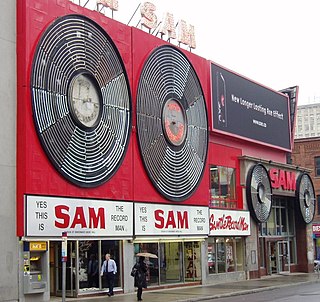
Sam the Record Man was a Canadian record store chain that, at one time, was Canada's largest music recording retailer. In 1982, its ads proclaimed that it had "140 locations, coast to coast".

State Street is a large south-north street, also one of the main streets, in Chicago, Illinois, USA and its south suburbs. Its intersection with Madison Street has marked the base point for Chicago's address system since 1909. State begins in the north at North Avenue, the south end of Lincoln Park, runs south through the heart of the Chicago Loop, and ends at the southern city limits, intersecting 127th Street along the bank of the Little Calumet River. It resumes north of 137th Street in Riverdale and runs south intermittently through Chicago's south suburbs until terminating at New Monee Road in Crete, Illinois.
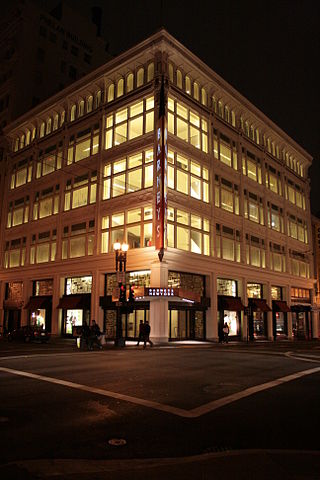
Barneys New York is an American department store chain founded in 1923 by Barney Pressman. The company operated full-line department stores in the United States from 1923 until 2020. Authentic Brands Group acquired Barneys' intellectual property in 2019, and has licensed the brand to Saks Fifth Avenue for specialty departments within its flagship stores since 2021.

Bergdorf Goodman Inc. is an American luxury department store based in New York City, founded in 1899 by Herman Bergdorf. As of 2024, it operates a women's store and a men's store across the street from each other on Fifth Avenue in Midtown Manhattan. It has been owned by the Neiman Marcus Group since 1987, and is a sister brand to the Dallas-based Neiman Marcus department store chain through this ownership.
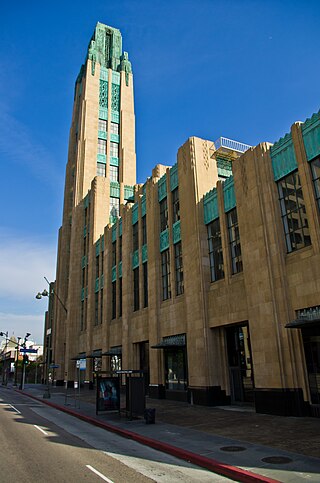
Bullocks Wilshire, located at 3050 Wilshire Boulevard in Los Angeles, California, is a 230,000-square-foot (21,000 m2) Art Deco building. The building opened in September 1929 as a luxury department store for owner John G. Bullock. Bullocks Wilshire was also the name of the department store chain of which the Los Angeles store was the flagship; it had seven stores total; Macy's incorporated them into and rebranded them as I. Magnin in 1989, before closing I. Magnin entirely in 1994. The building is currently owned by Southwestern Law School.

The Sullivan Center, formerly known as the Carson, Pirie, Scott and Company Building or Carson, Pirie, Scott and Company Store, is a commercial building at 1 South State Street at the corner of East Madison Street in Chicago, Illinois. Louis Sullivan designed it for the retail firm Schlesinger & Mayer in 1899 and later expanded it before H.G. Selfridge & Co. purchased the structure in 1904. That firm occupied the structure for only a matter of weeks before it sold the building to Otto Young, who then leased it to Carson Pirie Scott for $7,000 per month, which occupied the building for more than a century until 2006. Subsequent additions were completed by Daniel Burnham in 1906 and Holabird & Root in 1961.
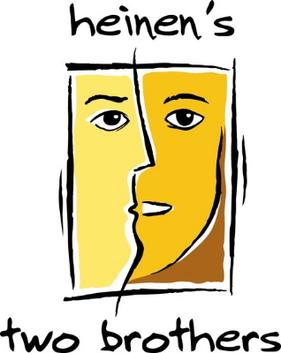
Heinen's is an American family-owned and operated regional supermarket chain that was founded in 1929. The chain has locations in Northeast Ohio and in the Chicago metropolitan area. It was founded by Joe Heinen, a butcher, who opened the first store near his butcher shop. The company now operates under the leadership of his grandsons Jeff and Tom Heinen and their children, Kim, Kelsey, and Jake Heinen.
Wieboldt Stores, Inc., also known as Wieboldt's, did business as a Chicago general retailer between 1883 and 1987. It was founded in 1883 by storekeeper William A. Wieboldt. The flagship location was at One North State Street Store in Chicago.
The H. & S. Pogue Company was a Cincinnati, Ohio based department store chain founded by two brothers, Henry and Samuel Pogue. They came from County Cavan, Northern Ireland, to Cincinnati and worked in their uncle's dry goods store. They later were able to buy him out and H. & S. Pogue Dry Goods Company was established in 1863 at 111 West Fifth Street. Brothers Thomas, Joseph, and William Pogue would eventually join the enterprise.

The Plaza, formerly known as Evergreen Plaza, was a shopping mall in Evergreen Park, Illinois, United States. It was legally organized by Arthur Rubloff, who is also credited with coining the phrase "Magnificent Mile" describing the upscale section of Michigan Avenue north of the Chicago River to Oak Street. Rubloff secured the funding for the Evergreen Plaza from the Walgreen family who lived nearby in Beverly, Chicago. The Evergreen Plaza operated from 1952 to 2013. It featured over 120 stores, as well as a food court. The mall closed in 2013 and became an outdoor shopping center. Anchors include Whole Foods Market, and Burlington Coat Factory.

The Marshall Field and Company Building is a National Historic Landmark retail building on State Street in Chicago, Illinois. Now housing Macy's State Street, the Beaux-Arts and Commercial style complex was designed by architect Daniel Burnham and built in two stages—north end in 1901–02 and south end in 1905–06. It was the flagship location of the Marshall Field and Company and headquarters Marshall Field's chain of department stores. Since 2006, it is the main Chicago and midwestern location of the Macy's department stores. The building is located in the Chicago Loop area of the downtown central business district and it takes up the entire city block bounded clockwise from the west by North State Street, East Randolph Street, North Wabash Avenue, and East Washington Street. Field and partners founded their Chicago store in 1852, and first built an expansive shopping emporium on this site in 1868. The 1901 building was the fourth for the department store at this site.

3 East 57th Street, originally the L. P. Hollander Company Building, is a nine-story commercial building in the Midtown Manhattan neighborhood of New York City. It is along the northern side of 57th Street, just east of Fifth Avenue. 3 East 57th Street, constructed from 1929 to 1930, was designed by Shreve, Lamb & Harmon in an early Art Deco style.
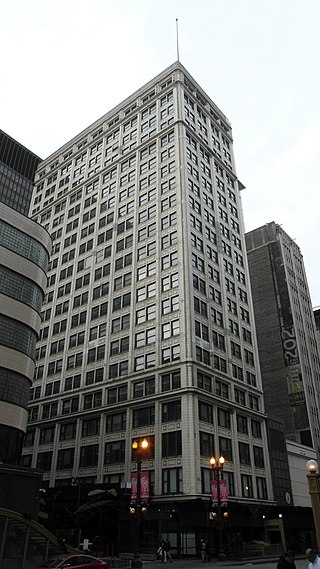
The Consumers Building is a Chicago school high rise office building in Chicago's Loop. It was designed by Jenney, Mundie & Jensen, and was built by Jacob L. Kesner in 1913. The building is owned by the General Services Administration and currently sits vacant. It is a contributing property to the Loop Retail Historic District.
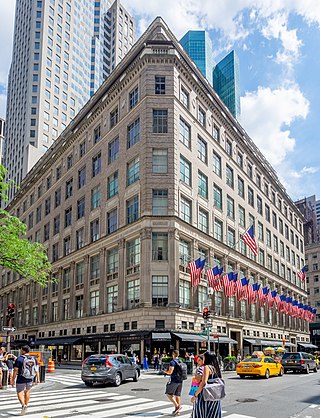
The Saks Fifth Avenue flagship store is a department store on Fifth Avenue between 49th and 50th Streets in Midtown Manhattan, New York City. The original 10-story structure at 611 Fifth Avenue has served as the flagship store of Saks Fifth Avenue since its completion in 1924. The store also occupies part of 623 Fifth Avenue, a 36-story tower completed in 1990.
References
- ↑ Key, Janet (28 February 1986). "Charles A. Stevens Chain Sold". Chicago Tribune . Retrieved 5 October 2018.
- ↑ "Chas A. Stevens Building". Chicagology. Retrieved 2 February 2023.